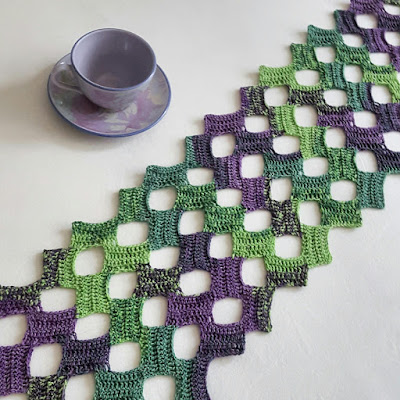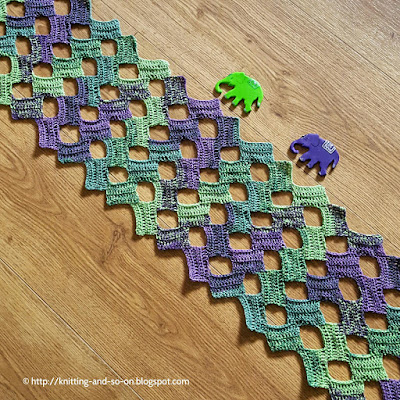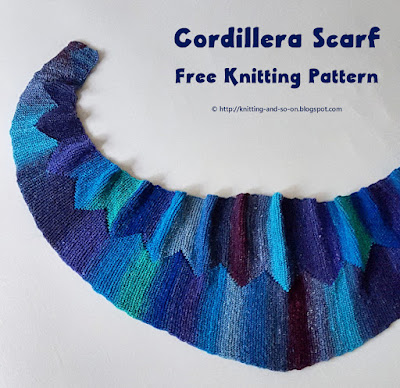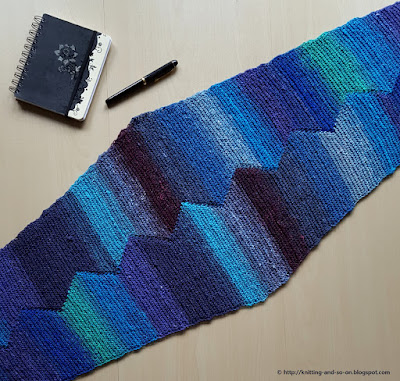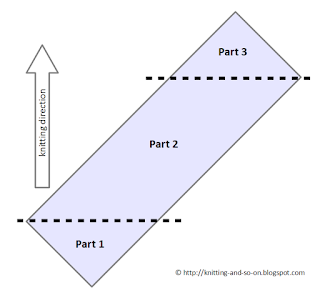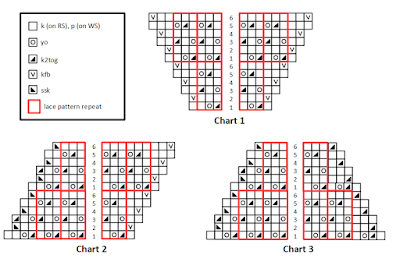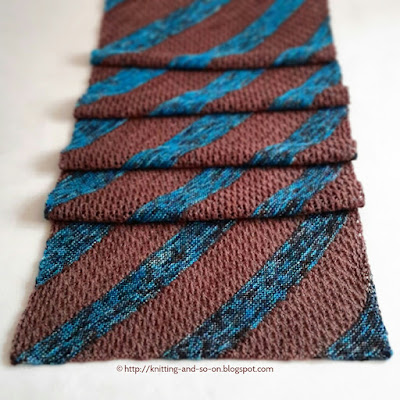Crochet yourself a fun summer accessory with this breezy scarf. It's constructed of rectangular modules that are connected as you go.
This scarf is the crochet version of my (knitted) Little Rectangles Summer Scarf.

This work by Knitting and so on is licensed under a Creative Commons Attribution-NonCommercial-ShareAlike 4.0 International License.
- DC = double crochet (US terminology) - as shown in this YouTube video by HappyBerry Crochet
- Chainless Double Crochet Foundation Stitch (CDCF): A way of starting with double crochet stitches without doing chain stitches first. It is shown in this YouTube video by Gleeful Things.
- Connected Chainless Double Crochet Foundation Stitch (cCDCF): Yarn over and insert your hook into the bottom of the last CDCF (see picture 1 below), yarn over and pull the yarn through once (see picture 2), then insert the hook of the edge of the next rectangle of the layer below (see picture 3), yarn over and pull through two loops (the one picked up from the next rectangle and the next on your hook (see picture 4), then finish like a normal DC.
 |
| How to do a Connected Chainless Double Crochet Foundation Stitch (click on image to enlarge) |
Materials
Since gauge doesn't matter here, you can basically use any yarn weight to crochet this scarf. I used the following
- about 120 grams of fingering weight yarn
- a 3.5 mm crochet hook
- a tapestry needle to weave in ends
Construction
This scarf is constructed in layers of DC rectangles (12 DCs wide and 4 rows high). Each layer consists of 5 rectangles one on top of the last one but with an offset of 8 stitches. The layers are at right angles to the layer below - at bit like entrelac, but with spaces inbetween.
The first rectangle of one layer connects with the fifth or last rectangle of the layer below, the second with the fourth rectangle, the third with the third of the row below, the fourth with the second and the fifth with the first from the row below. This construction is shown in the picture below.
If you like your patterns charted, here's a chart of the whole pattern. If you rather like written instructions see below.
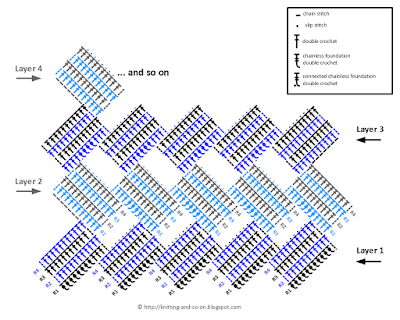 |
| Chart (click on image to enlarge) |
Instructions
First Layer
First rectangle
Row 1: ch 4, do a double crochet into the first chain, do 10 CDFCs, turn
Row 2: ch3, do 11 DCs (one into each double crochet in the row below), turn
Row 3 = Row 2
Row 4 = Row 2
Second to fifth rectangle
Row 1: starting with the 2nd DC in the row below, do 8 slip stitches, chain 3, do 3 DCs into the remaining DCs of the row below, do 8 CDFCs, turn
Row 2: ch3, do 11 DC (one into each double crochet in the row below), turn
Row 3 = Row 2
Row 4 = Row 2
Second Layer (and all subsequent layers)
First rectangle
Row 0: ch 7 (see illustration A1)
Row 1: ch 3, do 7 DCs (one into each ch of row 0). do 4 DCs into the side of rectangle 5 of the layer below, turn (see illustration A2)
Row 2: ch3, do 11 DCs (one into each double crochet in the row below), turn
Row 3 = Row 2
Row 4 = Row 2 (see illustration A3)
 |
| First rectangle of layers 2 and following (click on image to enlarge) |
Second to fifth rectangle
Row 1: starting with the 2nd DC in the row below, do 8 slip stitches, chain 3, do 3 DCs into the remaining DCs of the row below (see illustration B1), do 3 CDFCs, 1cCDFC (connecting it to the corner of the next rectangle in the layer below, see illustration B2), do 4 DCs into the side of this rectangle (see illustration B3), turn
Row 2: ch3, do 11 DCs (one into each double crochet in the row below),
Row 3 = Row 2
Row 4 = Row 2
 |
| Second to fifth rectangle of layers 2 and following (click on image to enlarge) |
Repeat this layer until the scarf is as long as you want it to be.
Weave in ends and block gently.
This post was featured at Fiber Tuesday Link Party #77 at OuiCrochet. Thank you!


